There Will Be Blood
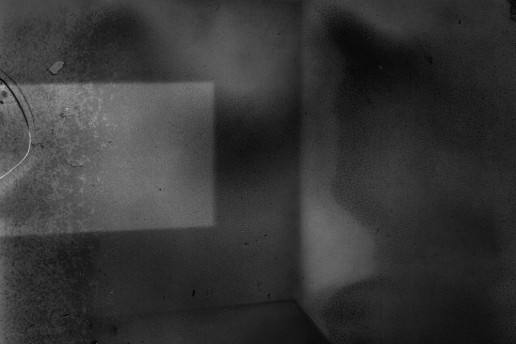
“… we live in a nomadic time”1
In 1992 architect John Hejduk declared the experience of his work as purely reflective of the times, experienced as if they, his buildings, could be anywhere or of any particular time. They contained something that will always attract and pull you in. In the same way, Daisuke Yokota’s current exhibition at G/P gallery is a collection of photographs that are equally as psychically involving as Hedjuk’s approach to architecture. They draw viewers in and place you amongst the sparsity of their surroundings.
Images of a figure walking, running away from and standing pensively in between very static objects; rooms, trees and landscapes neither night or day but entirely of their own space and time. “Site/Cloud” is a conglomeration of several bits of work by Yokota. Two self-published books, “Site” and “Back Yard”, are on display along with his portfolio. At times, when flicking through his portfolio, the same image reoccurs but each time differently, with something edited out or added. One photo of a house (not on display) appears several times, once with windows, and again with them removed; a shell of something real no doubt.
Yokota works in both digital and film formats. He re-photographs digital images with his analogue camera, and then develops the images over and over again so as to incorporate the inconsistency that developing by hand can lend itself to, where mistakes and errors give a sense of uniqueness unlike their digital counterpart. This process means the inevitable addition of foreign particles like scratches and marks, stray light and rogue sound. They stick to his works and give them a sense of personality. In effect, the resulting works lessen the presence or hand of the photographer behind the camera.
Yokota’s method of over-processing also means that the finished images often edit-out details. For example, his buildings become faceless over time, and so too for his figures which cut lonely and vivid silhouettes in dense surroundings (with the numbered titles, 07 and 09). Back gardens of weirdness (03), and strange juxtapositions of empty rooms (06) and back-streets feature too (01). As shown by 02, a pile of rubble has never looked so enigmatic.
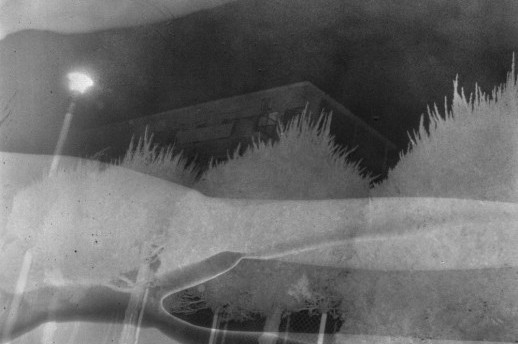
The scenes in Yokota’s photographs suggest a sense of architecture. His gardens, streets and bricks feel lived in unequivocally spatial. This architecture becomes about the process he goes through and the images he makes. Like early filmmakers, he searches for a spatial quality in his camera work, documenting things visually without the need to portray things truthfully. This process and the fascination with searching for a style within these places of production make his work truly architectural.
Like the earliest experiments in cinema occurring in the black tar-lined shed at the bottom of Thomas Edison’s garden, Yokota’s images marvel. Edison’s ‘Black Maria’ was a studio where cinematic effect and technique evolved to elicit wonders in the modern moving image of the late nineteenth century. Nicknamed The Doghouse by Edison (though ‘Black Maria’ was a nickname in itself), the heat and intensity inside that shed evoked as much fear and trepidation than it did a decent working environment. Whether it was intentional or not, Edison’s early images of native American Indians dancing and the flickering of wax candles caused a sensation and fear amongst those watching these tribal performances for the very first time. They bore the weight of their surroundings during the film’s process. Likewise, Yokota’s images describe a fascination with making, made using colour photos, re-photographed in black and white, enlarged, de-stressed and manipulated, at all times recording and constructing and placing a thematic emphasis on process.
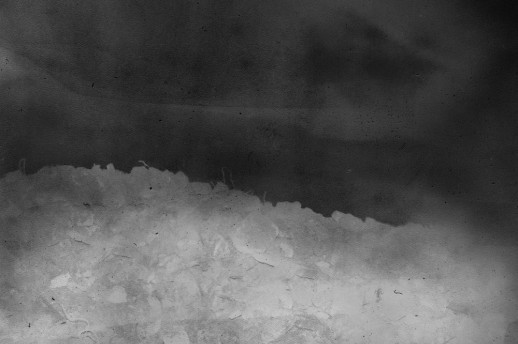
His work is clearly about shapes, matter, movement, and stillness, but Yokota does this without reducing elements and being purely ‘modern’ in his approach. If anything, you’re left thinking about the past as much as you are the future.
Yokota himself doesn’t noticeably figure in his work, but his figured silhouettes, just like Antony Gormley’s cast iron statues facing out to the Atlantic Sea and dotted around London, speak more about urban life as a struggle for the individual amidst the onslaught of contemporary life. His images are quiet, reflective, violent and obsessive. At times romantic, surreal and unsettling but never dystopic, mainly because they seem so familiar. If you’ve ever spent your childhood running through empty building sites or disused quarries, then this will ring true.
More than anything though is how consistent the artist has been throughout his career. The portfolio on display in “Site/Cloud” chronicles his work to date. From the crudity of his early sketches, his eye remains faithful to exploring and re-imagining again and again. It’s a continuous process, enlarged and re-reproduced.
If you’re left wondering what the point to “Site/Cloud” is, it questions the nature of photography as representation. Is it something which simply hangs on the wall or sits in a book or could it be something more provocative?
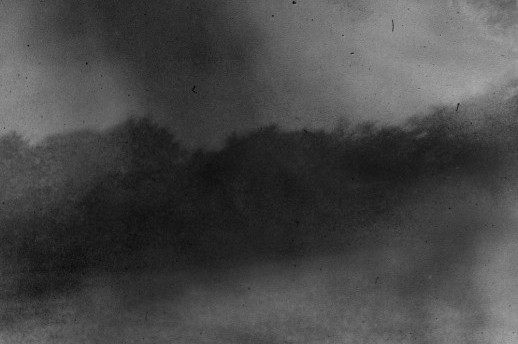
In Donald Ritchie’s book, A Hundred Years of Japanese Film, Robert Schwartz describes the motionless camera work in Takeshi Kitano’s 1989 film ‘Violent Cop’ (Sono otoko, kyōbō ni tsuki) as capturing “quiet, pensive stretches that served to build tension and the eye would be equally unblinking to the ruthless and relentless violence.”2 There is a violent edge to Yokota’s photography, as if he is beating the hell out of his camera and enlargements as if to make them acquiesce to his impression rather than the image recorded.
As with Kitano’s cinema, these images involve you as a witness to their unfolding strangeness and possible terror. Yokota’s own Black Maria, his darkroom, is the laboratory of story-less experiments that allow you to imagine what’s happening, without which you’d have no real sense of the unfolding possibilities they hint at. His work, caught between static buildings and passing clouds, is equally extreme.
“Site/Cloud” is aggressive and hard work. It’s emotional and requires the blood, sweat and tears he clearly pours into every image. Fortunately for us, in a photographic climate that brims with sentimental imagery, “Site/Cloud” provides us with a bit of photographic violence. Blood has been spilt and it’s a welcome sight.
1 From John Hejduk: Builder of Worlds (1992, 30 minutes, color)
2 A quote by Robert Schwartz, from Donald Ritchie, A Hundred Years of Japanese Film, Kodansha International (2006) pp.224-227
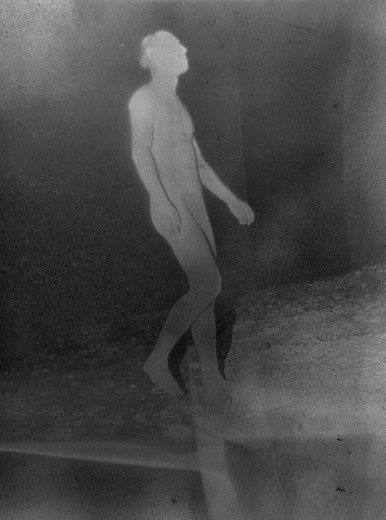
Stuart Munro
Stuart Munro


